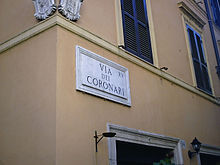Via dei Coronari
The Via dei Coronari is an approximately 500-meter-long street between the Vicolo del Curato and Via di Sant'Agostino in the historic district of Rione Ponte of Rome .
It owes its current name to the sellers of rosaries (Italian: "corona del rosario" or simply "corona") and other devotional objects that had settled in the street between the historic center and St. Peter's Basilica in the Middle Ages .
history
The name of the street was originally Via Recta ("Straight Street") because it was one of the few streets with a regular shape in the historic center of Rome. In the Middle Ages it was the fastest way to get from the Ripetta port on the Tiber to Sankt Peter and, what is no longer entirely clear today, formed an inverted “L” with the streets Via di Ripetta and Via della Scrofa, starting from the Piazza del Popolo , which connected this with the Angel's Bridge . It was therefore heavily frequented by pilgrims, which favored the settlement of sellers of devotional items and thus represents the reason for the current name of the street. Then as now it was and is the custom for pilgrims to bring their own, not yet consecrated rosaries to the regular general audiences of the Pope in order to have them blessed by him there.
At the beginning of the sixteenth century, the street and its surroundings were known for having been home to some of the most famous courtesans of their day, including Fiammetta Michaelis , one of Cesare Borgia's lovers . Many of the Florentine Renaissance artists who were called to Rome, such as Michelangelo , Raphael and Leonardo da Vinci , lived and worked in Via dei Coronari and its side streets .
Today the street is known for the many antique dealers and restorers and is a special attraction because of its almost untouched building fabric from the Middle Ages and the Renaissance.
building
A section of the street was previously named Immagine di Ponte because of a shrine with a picture showing the Coronation of the Virgin, built in 1523 by Antonio da Sangallo the Younger under the Palazzo of Cardinal Serra di Monserrato and still in its place .
In Via dei Coronari there is a building that probably dates back to the late 14th century, which could possibly have been the first of four houses of the Fiammetta Michaelis . Her second house is still located in the nearby Piazza Fiammetta , which has been named after her since the 17th century and which is one of the few public spaces named after a prostitute.
The Teatro dei Coronari was located in the former church of Santi Simeone e Giuda in the small side street Via di San Simone until 2006 .
In the middle of the street is the small Piazzetta di San Simeone (Square of San Simeone) with its characteristic fountain.
Individual evidence
- ^ A b Mauro Lucentini: La grande guida di Roma. Per chi ama la città eterna e vuole conoscerla meglio in poco tempo (= Guide insolite. 4). Newton & Compton, Rome 1999, ISBN 88-8289-053-8 , p. 455.
- ^ Mauro Lucentini: La grande guida di Roma. Per chi ama la città eterna e vuole conoscerla meglio in poco tempo (= Guide insolite. 4). Newton & Compton, Rome 1999, ISBN 88-8289-053-8 , p. 456.
- ^ Claudio Rendina: Fiammetta, l'amante dei porporati, repubblica.it of April 16, 2007.
- ^ Mariano Armellini: Le chiese di Roma dal secolo IV al XIX. Rome 1891 .
